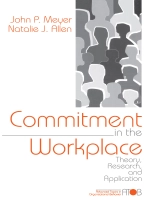What is a committed employee? Are employees who are committed better or worse off than employees who are uncommitted? What are the organizational advantages and disadvantages of having a committed workforce? Commitment in the Workplace provides an overview of academic and popular perspectives on what committed employees look like and how they become committed. The multiple faces of commitment are examined as are the links that have been established between the various forms of commitment and organizational behavior. In addition, questions concerning individual differences, organizational characteristics, and work experiences associated with commitment are explored. The book concludes with a discussion of what organizations can do to manage commitment effectively, including commitment under more difficult circumstances, such as merger/acquisition, downsizing, and relocation. One of the great strengths of the book is that it summarizes the key organizational commitment research in such a way that the research findings can be evaluated for both their scientific merit and their practical value. The primary audience for Commitment in the Workplace includes students in MBA and executive MBA programs, researchers, and students and practitioners in the fields of organizational behavior and industrial psychology.
Tabla de materias
Introduction
The Meaning of Commitment
The Consequences of Organizational Commitment
The Development of Organizational Commitment
Managing for Commitment
Multiple Commitments in the Workplace
A Look Back and a Look Ahead
Sobre el autor
Over the past several years, my research has examined the conceptualization, development, and consequences of work attitudes – in particular, the employee′s commitment to his or her organization and occupation. More recent research examines teams and work groups. Specifically, I am interested in the composition of such teams, the linkages between teams and the organizations in which they are embedded, and the reactions people have toward working in teams.












